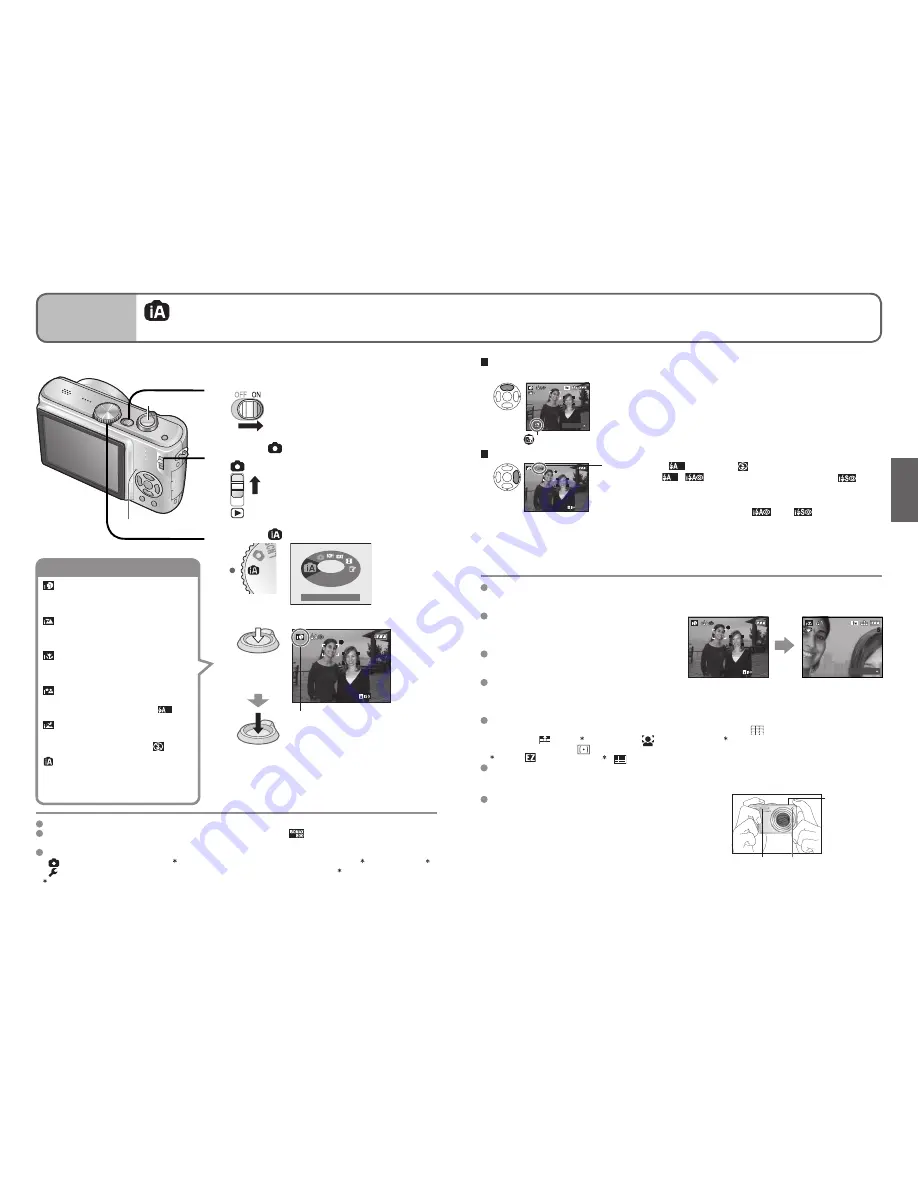
28
VQT1P98
VQT1P98
29
Basics
1
Taking picture with
automatic settings
Optimum settings are made automatically from information such as ‘face’, ‘movement’,
‘brightness’, and ‘distance’ just by pointing the camera at the subject, meaning that clear
pictures can be taken without the need to make settings manually.
Automatic scene distinction
1
Turn on the power
Status indicator illuminated for
approx. 1 second.
2
Set to
3
Set to
(INTELLIGENT AUTO mode)
INTELLIGENT AUTO
4
Take a picture
Press halfway
(Adjust the
focus)
Press fully
F3.3
F3.3
Recognised scene icon displayed in
blue for 2 sec.
• Camera reads scene when
pointed at subject, and
makes optimum settings
automatically.
Backlight compensation
(brighten subject against backlight)
55
BACKLIGHT
• To cancel compensation
→
Press
▲
again.
Displayed when compensation is on.
To use flash
F3.3
F3.3
Select either
(Auto) or
(forced flash off).
When using
,
(Auto/red-eye reduction) and
(Slow sync./red-eye reduction) will be switched between
automatically (see P.38 for details).
A second flash will be emitted in
and
for red-eye
reduction.
• Red-eye reduction may be activated and two flashes
emitted, according to conditions.
Focus range
→
(P.41).
In addition to automatic scene distinction, ‘INTELLIGENT ISO
’, ‘I.EXPOSURE’, ‘STABILIZER’,
and ‘CONTINUOUS AF’ will operate automatically.
The following menu items may be set in INTELLIGENT AUTO mode.
•
REC menu: ‘PICTURE SIZE ’, ‘ASPECT RATIO’, ‘BURST’, ‘COLOR MODE ’, ‘STABILIZER ’
• SETUP menu: ‘CLOCK SET’, ‘WORLD TIME’, ‘TRAVEL DATE’, ‘BEEP ’, ‘LANGUAGE’
Items that may be set differ from other recording modes.
Please set the clock before taking pictures (P.19).
Status indicator
Shutter button
Recognises ‘i PORTRAIT’
Follows face to take clear, bright
pictures.
Recognises ‘i SCENERY’
Takes sharp pictures of near and far
landscapes.
Recognises ‘i MACRO’
Reads distance to take sharp pictures
of close subjects
Recognises ‘i NIGHT PORTRAIT’
Takes bright, natural pictures of people
and night scenery. (Only with
)
Recognises ‘i NIGHT SCENERY’
Uses slow shutter speed to achieve
natural colouring.(Only with
)
Recognises movement
Reads subject movement to avoid
blurring when scene does not
correspond to any of the above.
e.g. Face too large – ‘i PORTRAIT’ becomes
‘i MACRO’
55
BACKLIGHT
F3.3
F3.3
According to the following conditions, different scene types may be determined for the same subject.
• Face contrast, conditions of subject (size, distance, colouring, movement), zoom ratio, sunset,
sunrise, low brightness, jitter
If desired scene type is not selected,
we recommend manually selecting the
appropriate recording mode.
(scene mode: P.44)
We recommend using a tripod and the self-
timer with ‘i NIGHT SCENERY’ and ‘i NIGHT
PORTRAIT’.
When jitter is small (e.g. using tripod) with ‘i
NIGHT SCENERY’, shutter speed can reach
a maximum of 8 seconds. Do not move the
camera.
The settings for the following functions are fixed.
•
AUTO REVIEW: 2 SEC. • POWER SAVE: 5 MIN. • GUIDE LINE:
• WHITE BALANCE: AWB
• QUALITY:
(Fine)
1
• AF MODE:
(Face detection)
2
• AF ASSIST LAMP: ON
• METERING MODE:
(Multiple)
1
0.3 M
only (standard)
2
(9 points) when face cannot be recognised
The following functions cannot be used.
‘HISTOGRAM’, ‘EXPOSURE’, ‘AUTO BRACKET’, ‘WB ADJUST.’, ‘DIGITAL ZOOM’, ‘MIN. SHTR
SPEED’, ‘AUDIO REC.’
Holding the camera
•
Do not block the flash or the lamp. Do not look at them
from close range.
•
Do not touch the lens.
•
Stand with your arms close to your body and with your
legs apart.
•
Do not block the microphone when recording audio.
• Holding camera vertically (
→
P.31)
Microphone
(top surface)
Flash Lamp






























